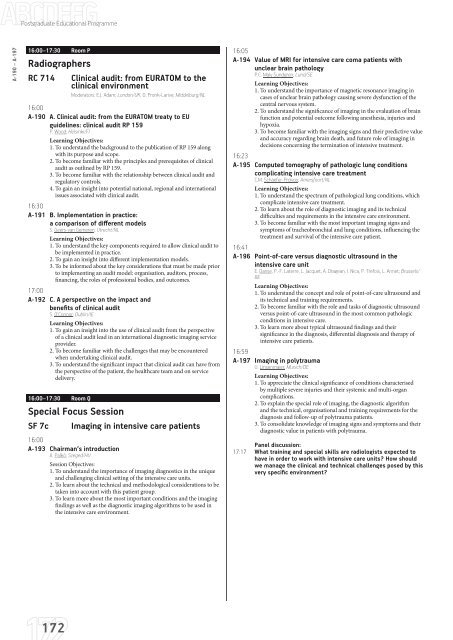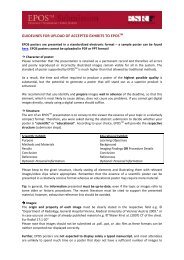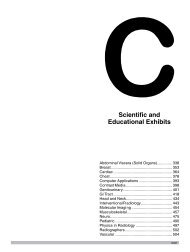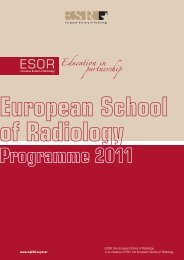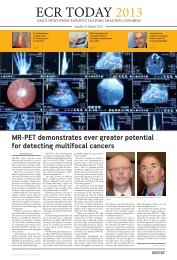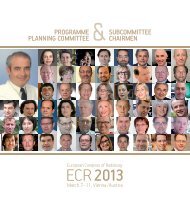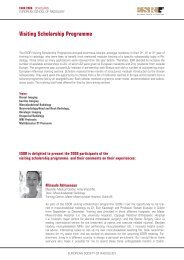ECR 2013 â Final Programme - myESR.org
ECR 2013 â Final Programme - myESR.org
ECR 2013 â Final Programme - myESR.org
- No tags were found...
Create successful ePaper yourself
Turn your PDF publications into a flip-book with our unique Google optimized e-Paper software.
Postgraduate Educational <strong>Programme</strong>A-190 – A-19716:00–17:30 Room PRadiographersRC 714 Clinical audit: from EURATOM to theclinical environmentModerators: E.J. Adam; London/UK, D. Pronk-Larive; Middelburg/NL16:00A-190 A. Clinical audit: from the EURATOM treaty to EUguidelines: clinical audit RP 159P. Wood; Helsinki/FILearning Objectives:1. To understand the background to the publication of RP 159 alongwith its purpose and scope.2. To become familiar with the principles and prerequisites of clinicalaudit as outlined by RP 159.3. To become familiar with the relationship between clinical audit andregulatory controls.4. To gain an insight into potential national, regional and internationalissues associated with clinical audit.16:30A-191 B. Implementation in practice:a comparison of different modelsS. Geers-van Gemeren; Utrecht/NLLearning Objectives:1. To understand the key components required to allow clinical audit tobe implemented in practice.2. To gain an insight into different implementation models.3. To be informed about the key considerations that must be made priorto implementing an audit model: <strong>org</strong>anisation, auditors, process,financing, the roles of professional bodies, and outcomes.17:00A-192 C. A perspective on the impact andbenefits of clinical auditS. O‘Connor; Dublin/IELearning Objectives:1. To gain an insight into the use of clinical audit from the perspectiveof a clinical audit lead in an international diagnostic imaging serviceprovider.2. To become familiar with the challenges that may be encounteredwhen undertaking clinical audit.3. To understand the significant impact that clinical audit can have fromthe perspective of the patient, the healthcare team and on servicedelivery.16:00–17:30 Room QSpecial Focus SessionSF 7c Imaging in intensive care patients16:00A-193 Chairman‘s introductionA. Palkó; Szeged/HUSession Objectives:1. To understand the importance of imaging diagnostics in the uniqueand challenging clinical setting of the intensive care units.2. To learn about the technical and methodological considerations to betaken into account with this patient group.3. To learn more about the most important conditions and the imagingfindings as well as the diagnostic imaging algorithms to be used inthe intensive care environment.16:05A-194 Value of MRI for intensive care coma patients withunclear brain pathologyP.C. Maly Sundgren; Lund/SELearning Objectives:1. To understand the importance of magnetic resonance imaging incases of unclear brain pathology causing severe dysfunction of thecentral nervous system.2. To understand the significance of imaging in the evaluation of brainfunction and potential outcome following anesthesia, injuries andhypoxia.3. To become familiar with the imaging signs and their predictive valueand accuracy regarding brain death, and future role of imaging indecisions concerning the termination of intensive treatment.16:23A-195 Computed tomography of pathologic lung conditionscomplicating intensive care treatmentC.M. Schaefer-Prokop; Amersfoort/NLLearning Objectives:1. To understand the spectrum of pathological lung conditions, whichcomplicate intensive care treatment.2. To learn about the role of diagnostic imaging and its technicaldifficulties and requirements in the intensive care environment.3. To become familiar with the most important imaging signs andsymptoms of tracheobronchial and lung conditions, influencing thetreatment and survival of the intensive care patient.16:41A-196 Point-of-care versus diagnostic ultrasound in theintensive care unitE. Danse, P.-F. Laterre, L. Jacquet, A. Dragean, I. Nica, P. Trefois, L. Annet; Brussels/BELearning Objectives:1. To understand the concept and role of point-of-care ultrasound andits technical and training requirements.2. To become familiar with the role and tasks of diagnostic ultrasoundversus point-of-care ultrasound in the most common pathologicconditions in intensive care.3. To learn more about typical ultrasound findings and theirsignificance in the diagnosis, differential diagnosis and therapy ofintensive care patients.16:59A-197 Imaging in polytraumaU. Linsenmaier; Munich/DELearning Objectives:1. To appreciate the clinical significance of conditions characterisedby multiple severe injuries and their systemic and multi-<strong>org</strong>ancomplications.2. To explain the special role of imaging, the diagnostic algorithmand the technical, <strong>org</strong>anisational and training requirements for thediagnosis and follow-up of polytrauma patients.3. To consolidate knowledge of imaging signs and symptoms and theirdiagnostic value in patients with polytrauma.Panel discussion:17:17 What training and special skills are radiologists expected tohave in order to work with intensive care units? How shouldwe manage the clinical and technical challenges posed by thisvery specific environment?172


